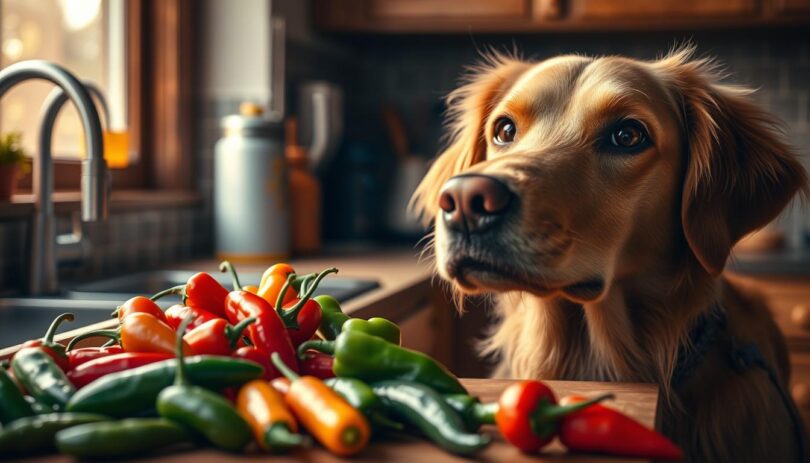Did you know pets experience spicy flavors differently than humans? While people have about 9,000 taste buds, our four-legged companions possess fewer than 1,700. This biological difference shapes how they interact with fiery ingredients like jalapeños.
Jalapeños contain capsaicin, the compound responsible for their heat. Veterinarians explain this substance triggers a burning sensation in mammals. Though not inherently poisonous, it often leads to stomach upset in animals.
Common reactions include vomiting, diarrhea, or excessive thirst. Pet owners might notice their furry friend pawing at their mouth or acting restless. These signs typically appear within hours of ingestion.
Experts emphasize prevention as the best approach. Offering safer vegetable alternatives avoids unnecessary risks. For those seeking deeper insights, upcoming sections explore canine biology and practical care strategies.
Understanding Canine Taste and Digestive Limitations
The way pets experience food involves more than just taste—it’s a complex interaction shaped by their unique anatomy. With only 1,700 taste buds compared to humans’ 9,000, their ability to detect flavors operates on a simpler scale. This biological gap explains why fiery ingredients register differently in their sensory world.
How Spicy Flavors Register Differently
When exposed to spicy food, animals rely less on taste buds and more on pain receptors. Capsaicin—the compound that creates heat in peppers—binds to nerve endings, causing irritation. While humans might enjoy this sensation, it often overwhelms a pet’s simpler palate.
Capsaicin’s Journey Through the Body
Once ingested, capsaicin can inflame the digestive system from mouth to stomach. Mild reactions like diarrhea or excessive drooling signal discomfort. Ingredients like garlic or chili in seasoned dishes add extra risks, as these are toxic to pets even in small amounts.
Owners should monitor meals closely and consult a veterinarian if unusual symptoms arise. Recognizing these biological boundaries helps create safer eating habits for four-legged family members.
The Science Behind Jalapeños and Canine Health
Spicy ingredients like jalapeños rank between 2,500-8,000 Scoville Heat Units. This measurement quantifies capsaicin concentration—the chemical responsible for their fiery kick. While humans might enjoy this heat, mammalian biology reacts differently to these compounds.
How Capsaicin Triggers Physical Reactions
Capsaicin binds to TRPV1 receptors in mammals, creating a burning sensation. These receptors line the mouth, throat, and stomach. Pets lack the enzymes to neutralize this irritant, leading to inflammation throughout their digestive system.
Digestive Consequences of Spicy Ingredients
Even mild heat levels can disrupt gut function. Common reactions include vomiting or diarrhea as the body attempts to expel the irritant. The intestinal lining may become temporarily inflamed, causing discomfort for several hours.
Animal digestive tracts evolved to process meat and simple carbohydrates—not capsaicin-rich foods. Owners should watch for signs like excessive drooling or lethargy after accidental ingestion. Consulting a veterinarian ensures proper care if symptoms persist beyond 24 hours.
Can Dogs Eat Jalapenos
When it comes to spicy treats, what’s safe for humans often becomes hazardous for pets. While jalapeños aren’t classified as poisonous, their composition makes them unsuitable for animal consumption.
Why Jalapeños Pose Risks
Capsaicin—the compound behind the pepper’s heat—triggers intense irritation in mammals. Pets lack biological defenses to neutralize this burning sensation. Even small amounts can inflame their mouth, throat, and digestive tract.
Many human dishes combine jalapeños with garlic or chili powder. These additives heighten toxicity risks. Garlic contains compounds that damage red blood cells in animals, creating additional health complications.
Recognizing Adverse Reactions
Watch for excessive drooling or pawing at the mouth—early signs of discomfort. Digestive distress often follows, including vomiting or diarrhea. Some pets show lethargy or refuse food due to stomach pain.
Severe cases may involve labored breathing or tremors. Immediate veterinary consultation becomes crucial if these symptoms appear. Quick action helps prevent dehydration and long-term gastrointestinal issues.
Opting for vet-approved snacks ensures pets enjoy treats without unnecessary risks. Always check ingredient lists and avoid sharing seasoned human foods.
Managing Accidental Jalapeño Ingestion
Quick action matters when pets encounter spicy ingredients. Start by removing any remaining peppers from reach to prevent further consumption. Wipe your hands and your companion’s paws with a damp cloth to eliminate lingering capsaicin residue.
Immediate Steps to Protect Your Pet
Offer fresh water to help dilute the irritant in their digestive system. Avoid milk or dairy products—they won’t neutralize capsaicin. Create a quiet space for rest, as stress worsens gastrointestinal discomfort.
Observe closely for signs like bloating or repeated lip-licking. Mild stomach pain often appears as restlessness or refusal to lie down. Track their hydration levels by checking gum moisture and skin elasticity.
When to Contact a Veterinarian
Seek professional advice if vomiting persists beyond two episodes or breathing becomes labored. Blood in stool or unsteady movements require urgent care. Emergency clinics handle toxin-related issues 24/7—keep their number accessible.
Even mild reactions benefit from veterinary guidance. Share details like quantity ingested and symptom timing. Early intervention prevents minor issues from escalating into severe health complications.
Takeaway Advice for Pet Owners
Protecting pets from dietary dangers requires awareness and proactive measures. While curious companions might investigate human snacks, ingredients like jalapeños often trigger painful reactions. Though not officially labeled as toxic, these peppers disrupt digestion and cause discomfort through their capsaicin content.
Prioritize nutritionally balanced meals tailored to animal biology. Store spicy items securely and avoid sharing seasoned dishes. If accidental exposure occurs, watch for signs like drooling or restlessness—these signal irritation needing attention.
Consult a veterinarian if unusual symptoms emerge after consuming problematic foods. They provide tailored advice for resolving digestive issues or managing complications. Always keep fresh water accessible to help dilute irritants during recovery.
Ultimately, a pet’s well-being hinges on mindful feeding practices. Stick to vet-approved treats and educate household members about risky ingredients. By focusing on safe nutrition, owners safeguard their furry friend’s health while strengthening their bond.
FAQ
Why do dogs avoid spicy foods naturally?
Dogs have fewer taste buds than humans and lack specific receptors to process capsaicin, the compound responsible for heat in peppers. This makes spicy foods like jalapeños unappealing and potentially harmful to their digestive system.
What makes capsaicin dangerous for pets?
Capsaicin irritates mucous membranes in a dog’s mouth, stomach, and intestines. This can lead to vomiting, diarrhea, or abdominal pain. Unlike humans, pets lack the biological adaptations to tolerate such compounds safely.
How quickly do symptoms appear after ingestion?
Signs like drooling, gagging, or gastrointestinal distress typically emerge within 1–3 hours. Severe reactions, such as lethargy or difficulty breathing, require immediate veterinary attention.










Leave a Comment